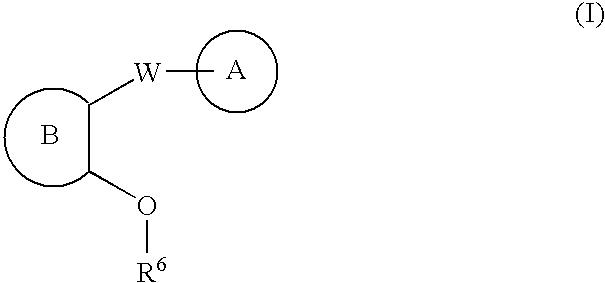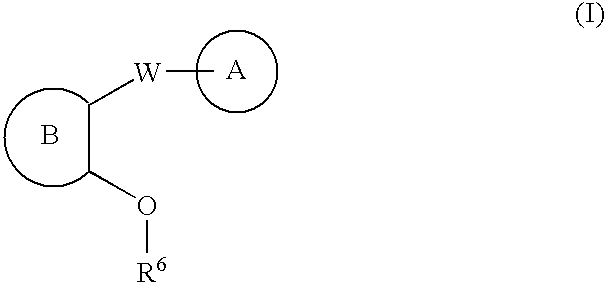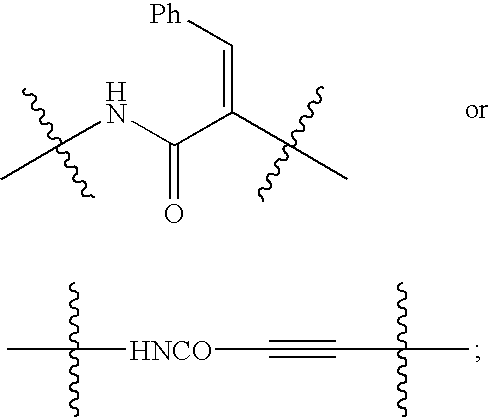Linear urea mimics antagonists of P2Y1 receptor useful in the treatment of thrombotic condition
a thrombotic condition and antagonistic technology, applied in the field of new urea mimics, can solve the problem that the antagonists lack the necessary pharmacological properties for in vivo study
- Summary
- Abstract
- Description
- Claims
- Application Information
AI Technical Summary
Benefits of technology
Problems solved by technology
Method used
Image
Examples
example 1
[0242] Cinnamoyl chloride (300 mg, 1.8 mmol) was added to a solution of 2-(2-tert-butylphenoxy)pyridin-3-amine (385 mg, 1.6 mmol) and 4-dimethylaminopyridine (20 mg) in pyridine (8.0 mL) at room temperature under argon. The mixture was stirred at rt for 16 h, and a saturated ammonium chloride solution was added (10 mL) along with dichloromethane (20 mL). The separated aqueous layer was extracted with dichloromethane (3×20 mL) and the combined organic layers were washed with brine, dried (anhydrous sodium sulfate), filtered and evaporated to yield an oily residue which was purified using flash-chromatography (dichloromethane with linear increments of triethylamine) to afford the title compound. Alternatively, Example 1 and related analogs could be prepared using standard peptide coupling protocols with (in this case) cinnamic acid, EDCI and HOBt in dichloromethane, albeit in lower yield. (M+H)=373. 1H nmr (400 MHz, CDCl3) δ ppm: 1.44 (s, 9H), 6.58 (d, J=15.4 Hz, 1H), 6.00 (dd, J=7.8,...
example 30
4-tert-butyl-N-(2-(2-tert-butylphenoxy)pyridin-3-yl)benzenesulfonamide
[0243] To a solution of 2-(2-tert-butylphenoxy)pyridin-3-amine (1a) (20 mg, 0.083 mmol) in pyridine (0.75 ml) was added 4-tert-butylbenzene-1-sulfonyl chloride (20 mg, 0.086 mmol). The reaction was allowed to set at rt overnight. Solvent was removed under vacuum. Purification by Prep. HPLC (C18 28 mm×100 mm, 20-100% solvent B, 10 min. gradient, 4 min. hold, 25 ml / min: solvent A=10% MeOH / Water+0.1% TFA, solvent B=90% MeOH / Water+0.1% TFA) provided Example 30 (16.3 mg, 0.037 mmol). (M+H)+=439.28.
example 56
2-(2-tert-butylphenoxy)-N-(3-phenylpropyl)pyridin-3-amine
[0244] To a solution of 2-(2-tert-butylphenoxy)pyridin-3-amine (1a) (92 mg, 0.38 mmol) and hydrocinnamaldehyde (76.5 mg, 0.57 mmol) in dichloromethane (2.0 mL) was added acetic acid (21.7 μL, 0.38 mmol) at rt. The mixture was stirred at rt for 1 h and sodium triacetoxyborohydride (121 mg, 0.57 mmol) was added. The mixture was stirred at rt for 3 h and a solution of potassium carbonate in water was added. The separated aqueous layer was extracted with dichloromethane (3×15 mL) and the combined organic layers were washed with brine, dried (anh. magnesium sulfate), filtered and evaporated. Purification by Prep. HPLC (C18 20 mm×100 mm, 20-100% solvent B, 10 min. gradient, 7 min. 20 ml / min: solvent A=10% MeOH / Water+0.05% ammonium acetate, solvent B=90% MeOH / Water+0.05% ammonium acetate) provided Example 56 (90 mg, 0.24 mmol). (M+H)+=361.
PUM
| Property | Measurement | Unit |
|---|---|---|
| Carrier mobility | aaaaa | aaaaa |
| Electrical conductance | aaaaa | aaaaa |
| Electrical conductance | aaaaa | aaaaa |
Abstract
Description
Claims
Application Information
 Login to View More
Login to View More - R&D
- Intellectual Property
- Life Sciences
- Materials
- Tech Scout
- Unparalleled Data Quality
- Higher Quality Content
- 60% Fewer Hallucinations
Browse by: Latest US Patents, China's latest patents, Technical Efficacy Thesaurus, Application Domain, Technology Topic, Popular Technical Reports.
© 2025 PatSnap. All rights reserved.Legal|Privacy policy|Modern Slavery Act Transparency Statement|Sitemap|About US| Contact US: help@patsnap.com



